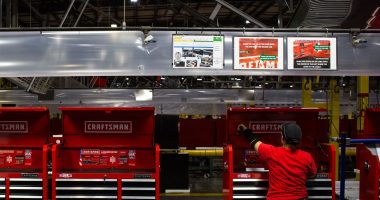
Despite attracting a lot of attention in job market coverage, the world is not made up of salary-earning data analysts and software engineers. In fact, 55.6% of all U.S. wage and salary workers were paid at hourly rates in 2022, according to the Bureau of Labor Statistics. Industries like health care, hospitality, retail and manufacturing make up this massive cohort, and that doesn’t even include the gig work economy.
In that majority lies a pressing question: How will the introduction of artificial intelligence impact hourly workers?
According to workplace management software company Deputy’s Big Shift Report 2024 on the evolving labor market, 70% of shift workers expressed the belief that AI will bring changes to their jobs.
But AI won’t be the same as past technology-led changes to labor. Previous technology and industrial revolutions have primarily disrupted the blue-collar sector, but according to Silvija Martincevic, CEO of Deputy, since AI is digitizing general intelligence, “we actually think that this is the first time where there will be massive disruption to knowledge workers.“
She foresees resilience to AI disruption in sectors requiring a human touch, like elderly care, hospitality and other services. “All of these industries are staffed by hourly workers,” she said.
Not all experts believe AI and disruption go hand in hand — for any kind of worker. “I don’t really love the disruption connotation,” said Doug Hammond, president of operational talent solutions at staffing and temporary work agency Randstad USA. “I think that word comes with a lot of ‘sky is falling’ kind of baggage.”
Hammond said AI is more about the “rapid evolution of technology that allows step-function increases in productivity.”
‘Deskless workers’ and technology
Regardless of the perspective, hourly workers and the people who manage them are actively seeking technology solutions to help streamline their workflow. In a survey of hourly workers, 22% were interested in using AI in their work and 23% have already experimented with AI tools, according to the latest annual report from instant payment platform Branch.
Martincevic says Deputy’s clients, which include Ace Hardware and Dutch Bros Coffee, have asked for more engagement tools to ensure hourly workers feel connected to the workplace. Often referred to as deskless employees, shift workers haven’t experienced a tangible technological renaissance in the way desk-based workers have via project management tools, video conferencing and asynchronous collaboration platforms.
Hammond says shift-work industries have been undergoing automation for years, going from individuals to machines to computer-driven processes. For example, robotics-enabled sorting and small item picking is infiltrating the logistics industry, which is traditionally staffed by hourly workers on the warehouse floor. But he says that doesn’t mean replacement. “That opens up opportunities for folks to upskill into higher-level decision-making roles: robotics maintenance, planning and strategy,” Hammond said.
He added, “What you’re going to see is the ability to supercharge productivity and allow workers and employers to do even more, which is going to have an overall net positive impact on both the economy as well as workers’ happiness and livelihood.”
Among the key stakeholders to this labor market megatrend, beyond employers and employees, is an education and training system that isn’t caught up, Hammond says, placing more pressure on employers. “At the end of the day, employers need people to run their businesses,” he said. “If they can’t find those people at the wage rate that they can afford, they’re going to have to invest in upskilling. You either need to find or create this labor force.”
On the employee side, the pressure is focused on upskilling, which should be beneficial to a worker’s personal success. “A pick packer — someone who is in a logistics facility picking items and putting them in a box — is not going to make as much as the robotics tech,” Hammond said. But it remains a big unknown if actual compensation in the long term will rise to match a new set of responsibilities that replace automated, older tasks.
A tight global job market
The global labor market is going to remain tight, according to experts, leaving companies competing for workers. The number of unemployed people was at a record low of 33.2 million last year for member-countries in the Organisation for Economic Co-operation and Development, which includes the U.S., U.K. and 36 other countries. While poly-employment — Deputy’s term for one worker having more than one job — has more than doubled for shift workers since 2021, there’s only so much time in one worker’s week. Increasing the value of an individual’s work — and subsequently their compensation — and optimizing their time to do more through technology could benefit all parties.
Martincevic believes that digitizing shift work will help solve an enormous market failure, a bullish sentiment that stems from numbers like the BLS prediction that more than 800,000 new home health and personal care aide jobs will be added to the market in the 10 years ending in 2032.
“This will be the decade of hourly workers that are focused on delivery of services that require human touch,” she said.
Turnover is high in the shift work economy. Legion’s latest State of the Hourly Workforce report says 62% of hourly employees plan to leave their jobs within the next year.
One thing that hourly workers, like all workers, aim for is a sense of meaning on the job. Inevitably, the less interchangeable someone feels, the more satisfied they will be at work, Hammond said. “People are motivated by doing work that they perceive to be meaningful, that allows them to demonstrate their value,” he added.
If AI is the answer to moving people up the value chain, it could make a world of difference. But that’s a big “if,” according to early worker surveys. According to the experts, it’s up to organizations and the economic web to determine whether these workers who take the time to upskill will actually be rewarded for it in tangible ways.
Read More: World News | Entertainment News | Celeb News
CNBC










